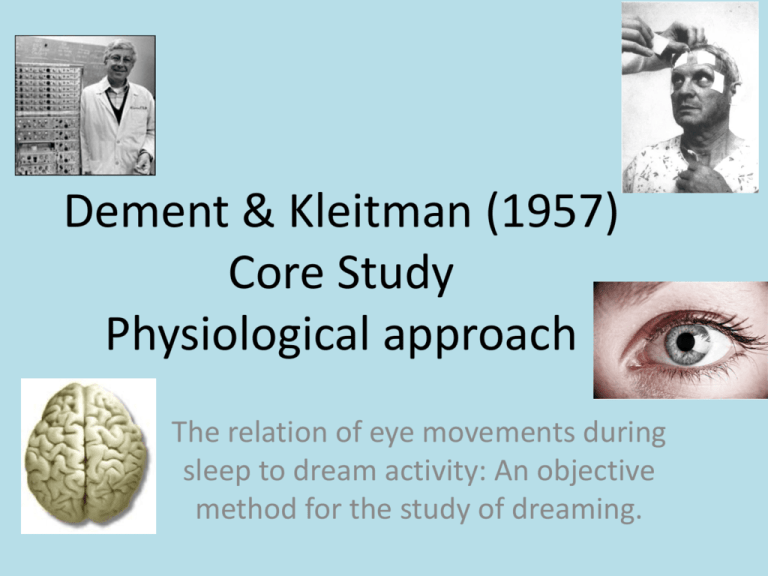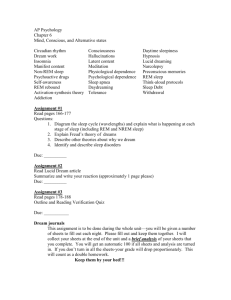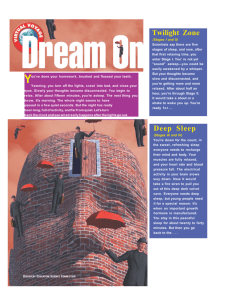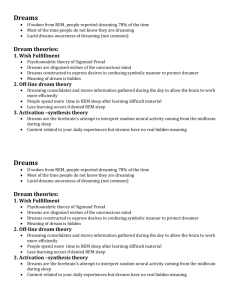D & K PPT - WordPress.com
advertisement

Dement & Kleitman (1957) Core Study Physiological approach The relation of eye movements during sleep to dream activity: An objective method for the study of dreaming. Recap quiz of Social approach 1) In the core study by Milgram, participants were; A) B) C) D) 50 Males aged 20 – 50. 40 Males aged 20 – 50. 40 Males aged 30 – 60. 40 Males and Females aged 20 – 50. 2) Which of the following was not a prod used by the experimenter? A) The experiment requires that you continue. B) Please continue. C) I will take the responsibility for what happens here today. D) It is absolutely essential that you continue. 3) Milgram’s results showed A) 100% of participants shocked the learner up to 300V. B) 65% of participants shocked the leaner up to 450V. C) Participants showed a variety of nervous physiological reactions to the task. D) All of the above. 4) If a person supresses their values and no longer feels responsible, this is know as being; A) B) C) D) In an agentic state In an autonomous state Cognitively dissonant Collectivist 5) What was not an independent variable in Piliavin et al’s experiment? A) B) C) D) Type of victim (lame or drunk) Race of victim Group size Gender of victim 6) Results for Piliavin et al showed A) B) C) D) Males were more helpful than females A slight tendency for same race helping No evidence for diffusion of responsibility All of the above 7) What is the term used to describe people looking to others to define a situation if it is ambiguous? A) B) C) D) Bystander apathy Diffusion of responsibility Pluralistic ignorance Model intervention 8) Reicher & Haslam conducted a study which is an example of a A) B) C) D) Naturalistic observation Laboratory experiment Experimental case study Field experiment 9) Which of the following was not an independent variable for R & H? A) B) C) D) Permeability Legitimacy Cognitive alternatives Group identification 10) Reicher & Haslam found the situation to have an effect on A) B) C) D) Social identification of guards and prisoners Group self-efficacy of guards and prisoners Depression levels of guards and prisoners All of the above Dement & Kleitman (1957) Core Study Physiological approach The relation of eye movements during sleep to dream activity: An objective method for the study of dreaming. Learning Objectives • Be familiar with the context of study into sleep and dreaming by understanding stages of sleep and REM. • Be able to identify the three hypotheses for the study. • Be able to outline the research procedure and the results of the study. • Be able to discuss the relationship between REM and dreaming. Differences between social and physiological psychology SOCIAL ASSUMPTION Social context is extremely influential in shaping behaviour. Our behaviour is influenced by the imagined or implied presence of others. PHYSIOLOGICAL ASSUMPTION Behaviour and experience can be explained by physiological changes i.e. our biology. Investigates the brain, nervous system and other biological factors e.g. hormones. Is sleep important? Is sleep important? We spend 1/3 of our lives asleep. Average person will spend 25 years of their life asleep. What happens if we don’t sleep? • • • • • • • Logic and reasoning affected Difficulty concentrating Memory problems Depression and anxiety General paranoia Hallucinations Increased risk of various medical conditions e.g. heart disease, diabetes, obesity. Sleep is an active NOT a passive behaviour. Examples of sleep deprivation Peter Tripp 1959 200 hour wakeathon on American radio. Began to hallucinate, saw spiders in his shoes, thought one of the scientist there to look after him was an undertaker coming to bury him. Randy Gardner 1960s Set out to break world record for longest time spent awake (11 days) Effects = contracted problems with his eyesight, speech and memory problems, started to hallucinate towards end of experiment. Why do we sleep? Why do we sleep? Evolutionary theories – All animals sleep so it must have some valuable function (survival of the species), energy conservation, predator avoidance. Restoration theories – Repair and restore the brain (e.g. growth hormones released) and body (e.g. repair muscle tissue). Brain processing and memory consolidation theories – People need sleep to process information acquired during the day, transform information into long-term memory etc. Why do we dream? Why do we dream? PYSCHOANALYSIS - FREUD Dreaming is the ‘royal road to the unconscious’. We dream to fulfil wishes. Dreams are symbolic, repressed fantasies. COGNITIVE – INFORMATION PROCESSING THEORIES As our brain is dealing with the multitude of information and memories that we experienced during the day, our brain creates images and a narrative to manage this activity. PHYSIOLOGICAL - ACTIVATION SYNTHESIS MODEL During REM sleep, circuits in the brain become activated which causes certain areas of our brain associated with emotions and memories to become active. The brain interprets this internal activity and attempts to find a meaning which results in dreaming. How can we objectively measure sleep? 1) ElectroEncephaloGram (EEG) – Records brain activity/waves 2) ElectroOculoGram (EOG) – Records eye activity 3) ElectroMyoGram (EMG) – Records muscle activity Electroencephalogram (EEG) Electro (electric) En Cephalo (in the head) Gram (drawing) • The EEG machine uses recording electrodes (stuck to the skin or scalp) to detect the simultaneous activity of groups of neurons in the brain. • It produces a chart (an encephalogram) which shows how ‘brain waves’ vary i.e. how the frequency and amplitude (height) of electrical output from the brain changes over time. • These charts show that we go through several cycles of sleep a night. Electrooculogram (EOG) Electro (electric) Oculo (relating to the eyes) Gram (drawing) The EOG machine uses electrodes placed on the skin on either side of the eye to record frequency of eye movements. Records eye activity. The sleep cycle Read P 33 and P35 in your booklet AND the sleep stages handout Use the information to complete the sleep cycle worksheet NREM OR SWS Non Rapid Eye Movement or Slow Wave Sleep STAGE 1 Theta waves Lowered heart rate, muscle tension and body temperature. Can be easily awoken in this stage. STAGE 2 Slower and larger EEG waves and sleep spindles (bursts of high frequency waves) which last for about 1 second. A person can still easily be awoken. STAGE 3 Delta waves, large and slow. People in stage 3 do not easily respond to external stimuli and can be difficult to wake up. STAGE 4 Delta waves, deepest of all 4 stages. Metabolic activity low and people are very difficult to wake up. EEG OF NREM SLEEP CYCLES What happens next? REM (RAPID EYE MOVEMENT) REM sleep occurs roughly every 90 minutes and is associated with various physiological changes in the body 1) 2) 3) 4) Eyes begin to dart back and forth under the eyelids. Heart rate increases. Skeletal muscles relax (paralysis). Brain waves are fast – resembling the awake stage. After REM has finished (approx 15 minutes), the sleep cycle starts again. https://www.youtube.com/watch?v=H0DJzFDOgzg – REM video The sleep process • When asleep you descend through the stages but after reaching STAGE 4 you ascend to STAGE 3 and to STAGE 2. • From STAGE 2 you ascend through stage 1 to REM. • REM lasts approximately 15 minutes and then you return to STAGE 2. • This cycle is repeated throughout the night but with each cycle the amount of deep sleep shortens and the amount of REM sleep lengthens. • Each cycle lasts approximately 90 mins. How would you draw this? Research context Previous research had demonstrated: • The cyclic change in depth of sleep, as measured by EEG. • A relationship between REM and dreaming (Aserinsky & Kleitman, 1955). Sleep and dreaming https://www.youtube.com/watch?v=GidiLjnbNG c Featuring Kleitman The Core Study – Dement & Kleitman (1957) Group 1: Aim, hypotheses, variables (Ivs and Dvs) Group 2: Methodology, participants, materials Group 3: General procedure Group 4: Procedure for hypotheses 1, 2 and 3. The Core Study – Dement & Kleitman (1957) WHAT DID THEY WANT TO FIND OUT? AIM To see if the physiological aspects of REM sleep relate to participants’ experiences of dreaming. I.e. to determine the relationship between eye movements and dreaming. Three questions, three hypotheses 1) Will people be more likely to report dreams if they are awoken during periods of REM than during periods of NREM sleep? There will be a significant association between REM and reported dreaming. 2) Can people accurately estimate duration of dreaming? There will be a significant positive correlation between estimates of dream length (subjective) and measurement of REM sleep (objective). 3) Is the direction of eye movement during REM sleep related to dream content? There will be a significant association between the pattern of eye movement and reported content of the dream. Correlations briefly A correlation = an association (extent to which two variables are related). Positive correlation – as one variable increases, the other increases. E.g. as temperature increases, so do sales of ice creams. Negative correlation – as one variable increases, the other decreases E.g. as alcohol consumption increases, inhibitions decrease. No correlation – no connection between the two variables E.g. number of people who own a cactus in Bradford and number of people who have a bath mat in Leeds. Variables Whether woken in REM sleep or NREM sleep Whether dream is recalled Whether woken after 5 minutes or 15 minutes of REM sleep Estimate of length of dreaming Movement of eyes Content of dream Methodology and participants Laboratory experiment involving the collection of data through observation (of objective measures) and self-report measures (participants spoke into a tape recorder). Participants 7 adult males and 2 adult females. 5 were studied intensively, 4 to confirm these results (only tested on 1 or 2 nights). Materials • Setting – a sleep laboratory with specialised equipment to objectively measure sleep. • Electrodes attached near the eyes to measure eye movement (EOG) and to the scalp to measure brain wave activity i.e. depth of sleep (EEG). • Doorbell used to wake participants. • Tape recorder to record recollections of what they had been dreaming about. What was the procedure? Procedure • Participants reported to sleep laboratory just before their usual bedtime (had been told to eat normally but avoid alcohol and caffeine on the day of the experiment). • Electrodes were attached around eyes to measure electrical activity and therefore eye movement (EOG). • Electrodes were attached to scalp to record brain waves (EEG) to measure depth of sleep. • Participants went to sleep in a darkened room. Procedure continued • At various times the participants were awoken by a doorbell. • On waking the participants immediately spoke into the tape recorder to report A) if they had been dreaming or not and B) to describe the content of their dream (they were only classed as dreaming if they could give a detailed description). • An experimenter listening outside the door and occasionally entered to further question the participant on some particular point of their dream. • Participants were not told whether their eyes had been moving. Procedure for hypothesis 1 Procedure for hypothesis 2 Procedure for hypothesis 3 Hypothesis 1 Procedure Participants were awoken in one of four ways:- 1) 2 participants were woken according to a random numbers table. 2) 1 participant was woken at the whim of the experimenter. 3) 1 participant was woken during 3 REM periods and 3 NREM periods. 4) 1 participant was woken randomly (but had been told he would only be woken during REM sleep). Hypothesis 2 Procedure Participants were woken either 5 or 15 minutes after REM sleep began and were asked to estimate the length of their dream by choosing between the two (5 or 15 minutes). Participants were asked to relate the content of their dream and the length of the narrative was correlated with the duration of REM sleep before they were awoken. Hypothesis 3 Procedure Participants were woken as soon as 1 of 4 patterns of eye movement had occurred for a minute and were asked what they had just been dreaming about. Patterns were: 1) Mainly vertical 2) Mainly horizontal 3) Both vertical and horizontal 4) Very little/no eye movement. GENERAL RESULTS FOR REM SLEEP RESULTS FOR HYPOTHESIS 1 RESULTS FOR HYPOTHESIS 2 RESULTS FOR HYPOTHESIS 3 General results for REM sleep All participants showed periods of REM every night that they slept in the laboratory (shown through EEG readings). Total number of awakenings (for all 9 participants) was 351 times over 61 nights, averaging 5.7 per participant per night. Average occurrence of REM was one period every 92 minutes for the whole group with variations between 70 and 104 minutes. The lengths of REM was between 3 minutes and 50 minutes and they tended to increase in length as the night progressed. Results Hypothesis 1 Does dream recall correlate with periods of REM sleep? • Participants were much more likely to recall dreams in REM sleep than NREM sleep. Total awakenings = 191 Total awakenings = 160 Therefore – there is a correlation between dreaming and REM so we accept HYPOTHESIS 1 200 150 • When no dream recall was recorded in REM this tended to be in the earlier periods of the night. • NREM dreams were usually within 8 minutes of REM sleep (poss recalling dreams from previous REM sleep?) Recall 100 No Recall 50 0 REM NREM Results Hypothesis 2 Is there a correlation between the estimate of dream length and time spent in REM? Woken after 5 mins Woken after 15 mins (REM) (REM) Correct Incorrect Correct Incorrect 45 6 47 50 40 30 20 10 0 13 Correct Participants were mostly accurate in their estimation of dream length. There was a significant correlation between the length of dreams (number of words in dream report) and the amount of time spent in REM. Therefore – there is a significant correlation between estimates of dream length and time spent in REM so we accept HYPOTHESIS 2 Incorrect 5 minutes 15 minutes One participant was responsible for a large proportion of incorrect estimates. Results Hypothesis 3 Will the direction the eyes are moving in be related to the content of the dream? Type of eye movement Number of times Examples of Dream content Vertical 3 Looking up at a cliff Climbing a ladder Throwing basketballs at a net. Horizontal 1 Watching two people throw tomatoes at each other. Vertical and horizontal 21 Talking to a group of people Looking for something. Non/very little 10 Driving a car and staring at the road Staring at an object. Eye movements appeared to be related to dream content, indicating that the eyes were moving as if seeing what the participants were dreaming about. Therefore there is a correlation between eye movement and dream content so we accept HYPOTHESIS 3 Conclusion Hypothesis 1? Dreams are related to REM sleep. Hypothesis 2? People do dream in real-time. Hypothesis 3? Eye movements are closely related to dream content. Discussion • EEG showed participants were at their lightest level of sleep during REM periods. • Participants awoken during NREM occasionally reported feelings of emotional states rather than narrative dreams i.e. anxiety, pleasantness • Eye movements related to dream content indicated that the eyes were moving as it seeing what the participant was dreaming about. • Objective measurement of dreaming may be achieved by recording REMS whilst people sleep. Discussion continued HOWEVER • Babies in the womb - have periods of REM yet they must be unable to recall objects and events as they have no experience of them. • Individual differences - Later studies showed that not everyone follows this pattern so it is likely that significant individual differences exist between people in respect to dreaming. • Cause and effect - A significant relationship was found between REM and dreaming but it cannot be confirmed that one causes the other or if they just coincide by chance. Learning Objectives • Be familiar with the context of study into sleep and dreaming by understanding stages of sleep and REM. • Be able to identify the three hypotheses for the study. • Be able to outline the research procedure and the results of the study. • Be able to discuss the relationship between REM and dreaming.




